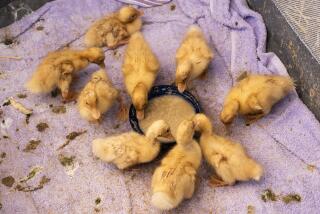U.S. May Resort to Poisoning Sea Gulls to Keep Rare Migratory Birds at Cape Cod
- Share via
CHATHAM, Mass. — The piping plovers and roseate terns due here this spring will find their nesting area crowded with thousands of gulls, renewing a battle blamed for the decline of the birds’ numbers off Cape Cod.
Thirty years ago, piping plovers and roseate terns outnumbered the gulls that nested on Monomoy Island during the spring and summer. Last year, just two pairs of piping plovers and seven pairs of roseate terns came to the Monomoy wildlife refuge, and they had to fight for survival with about 70,000 gulls.
The U.S. Fish and Wildlife Service, which runs Monomoy, this month released a master plan for the refuge that will permit the poisoning of gulls to make room for the rarer birds.
The gull population explosion has coincided with rampant residential development on the coast, where the gulls can feed on garbage in the landfills.
“We’re giving them a free, hot lunch every day and the terns and plovers just aren’t adaptable enough to take advantage of that opportunity,” said Thomas French, director of the state’s endangered species program.
“They are competing for the same piece of land and the gulls are much more aggressive,” French said. “They will eat the terns for lunch.”
There will be no poisoning this year, because the plan was released too late to conduct the necessary environmental study before the migrating shore birds arrive from the South. Jack Fillio, the refuge manager, believes the plan will be put to use next spring.
“I’m of the opinion that the gull population has expanded to the point where (poison) seems to be the most viable technology to use,” Fillio said in an interview last week. “You could study the issue until the plovers and terns are gone.”
Animal rights activists have denounced the plan, but state and federal environmental officials have reluctantly endorsed it as a means of restoring balance to the bird populations.
Only one pair of herring gulls was spotted at Monomoy in 1961, but more than 15,000 pairs have nested there since 1980. There were no black-backed gulls nesting at the refuge 25 years ago, but more than 5,000 pairs have made it their summer home in recent years.
Chris Lahey, conservation director for the Massachusetts Audubon Society, said provisions in the new master plan endorsing gull poisoning only as a last resort “sound like a step in the right direction.”
Because poison cannot be used this year, Fillio said refuge staffers will fence off tern and plover nests and disrupt any gull nesting near them.
Bradford Blodgett, a state ornithologist, said that nature may have an alternative to poison--a barrier island formed last year when a winter storm cut through a huge sand bar off Chatham. He said the area could become a gull-free home for terns and plovers.
If gull nesting is broken up on the new island, the terns and plovers could prosper undisturbed if they settle there, Blodgett said.
More to Read
Sign up for Essential California
The most important California stories and recommendations in your inbox every morning.
You may occasionally receive promotional content from the Los Angeles Times.










